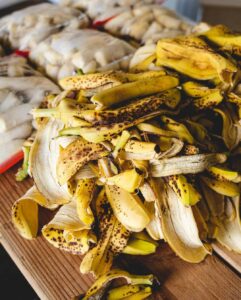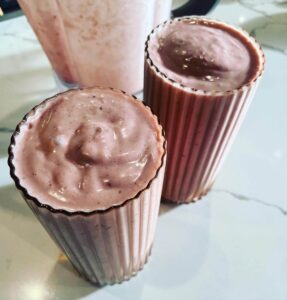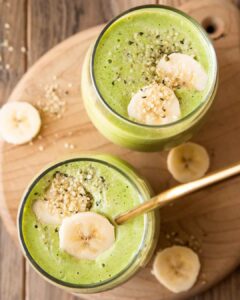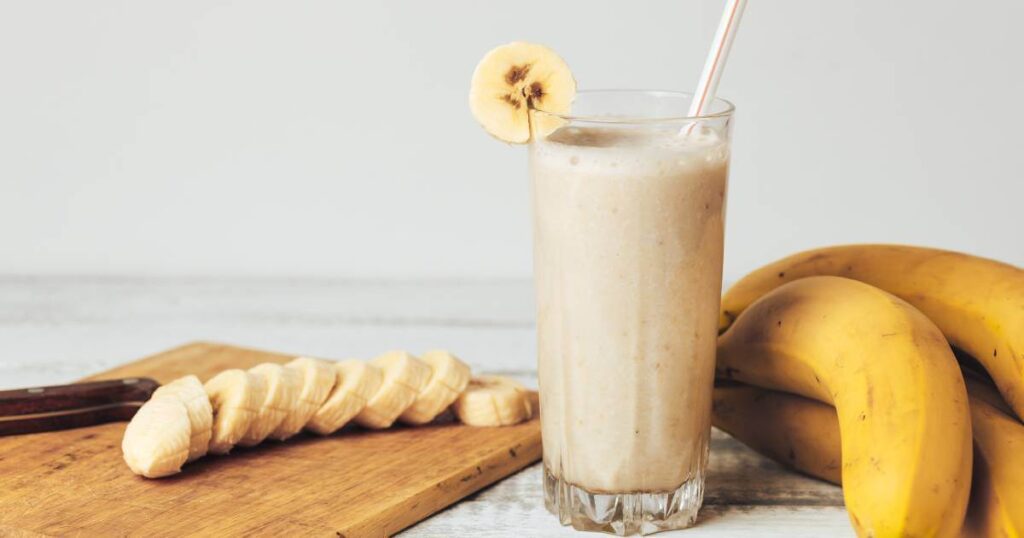What to know about banana smoothies
Table of Contents
Adding a ripe banana to your smoothie is more than just a sweet move, it’s the secret to creamy perfection.
Bananas in smoothies don’t just add thickness, they pack a nutritional punch that’ll boost your morning routine without weighing you down.
Why do people always put bananas in smoothies?
Bananas add a creamy texture that makes your drink rich and satisfying. Unlike many other fruits, bananas blend smoothly without leaving chunks or fibrous bits.
This means each sip is as silky as the last.
The natural sweetness of bananas help sweeten your smoothie without added sugars, so you get to enjoy a healthier treat that still tastes indulgent.
Plus, they’re versatile! Whether you pair them with berries, spinach, or peanut butter, bananas complement almost any flavor.
They also pack in nutrients like potassium and vitamin C, which support your health in many ways. Potassium is an electrolyte that’s amazing for hydration and muscle health, while vitamin C boosts your immune system.
But it’s not just about taste and nutrition; convenience matters, too! Bananas are easy to store and quick to prep—peel and toss into the blender. You don’t have to fuss over seeds or tough skins.
Lastly, let’s talk about cost-effectiveness: Bananas are budget-friendly compared to other popular smoothie fruits.
Why we love bananas in smoothies
- Creamy texture
- Natural sweetness
- Versatility with flavors
- Nutrient-rich
- Convenient
- Cheap
Banana nutritional facts
Bananas are a powerhouse of nutrients. An average-sized banana is not just sweet and creamy; it’s also packed with essential vitamins and minerals. Here’s what you get in one medium banana:
- About 105 calories
- 1.3 grams of protein
- 0.3 grams of fat
- 27 grams of carbohydrates
- 3 grams of fiber
This fruit is an excellent source of vitamin C, B6, and manganese. Vitamin B6 helps your body use and store energy from proteins and carbohydrates in food, while vitamin C keeps your skin healthy.
Bananas also contain a good amount of potassium, vital for heart health and normal blood pressure. A single banana can provide nearly 9% of your daily potassium needs.
Moreover, bananas have a low to medium glycemic index (GI), which measures how quickly foods increase blood sugar levels after eating them. This means they release their sugars slowly into the bloodstream, providing steady energy without spikes.
With all these benefits, it’s no wonder why bananas make such great additions to smoothies!
| Nutrient | Amount per banana (approx. 118 grams) | % Daily Value |
|---|---|---|
| Calories | 105 | 5% |
| Total Fat | 0.3g | 0% |
| Saturated Fat | 0.1g | 0% |
| Cholesterol | 0mg | 0% |
| Sodium | 1mg | 0% |
| Total Carbohydrates | 27g | 9% |
| Dietary Fiber | 3g | 12% |
| Sugars | 14g | — |
| Protein | 1.3g | 2% |
| Vitamin A | 76 IU | 1% |
| Vitamin C | 10.3mg | 17% |
| Calcium | 5mg | 0% |
| Iron | 0.3mg | 2% |
| Potassium | 422mg | 12% |
Pairing bananas with for maximum nutritional value
To maximize nutritional benefits when adding bananas into smoothies, pair them with ingredients that enhance each other’s effects (aka. bioavailability). For instance, combining bananas with spinach gives you iron plus vitamin C which helps you absorb it better.
Yogurt is another smart addition because it provides calcium, which works well alongside the potassium found in bananas. This combination helps maintain strong bones while keeping muscles working properly.
- Spinach: Contains iron; pairs well with vitamin C.
- Yogurt: Offers calcium; complements banana’s potassium.
A combo like this helps maximize the health benefits when pairing bananas with other ingredients.
On the flip side, some new research has found that adding a banana to fruit smoothies can lower the body’s ability to absorb flavanols, which are good for heart and brain health, due to an enzyme called polyphenol oxidase (PPO) found in fruits like banana. This finding, from research led by Javier Ottaviani, highlights the need to study more about how preparing food affects the benefits of flavanols.
Best substitutes
When searching for a substitute for bananas in smoothies, consider fruits with similar creaminess and nutrient profiles. Avocados are excellent; they’re packed with healthy fats that increase the bioavailability of vitamins. They also make your smoothie rich and creamy.
Another great choice is mangoes. Mangoes bring tropical sweetness, fiber, and vitamin C to your drink. You might not get the same texture as a banana, but the flavor is delightful.
- Avocado: Creamy texture, healthy fats.
- Mango: Sweet taste, high in fiber and vitamin C.
Remember, choosing substitutes depends on what nutrients you want to boost in your smoothie.
Best ways to include bananas in your smoothies
Here’s how you can best include bananas in your smoothies:
- Use ripe bananas for the sweetest flavor.
- Freeze bananas beforehand for an extra thick/cool consistency.
- Combine with other fruits like berries or mango for a nutrient-packed beverage.
- Add a spoonful of nut butter to complement the banana’s taste and increase protein content.
Remember, blending bananas with the right ingredients enhances their nutritional benefits. Avoid adding too much sugar or sugary fruits if you’re watching your calorie intake.
To make sure your smoothie stays healthy, here are some tips:
- Start with unsweetened almond milk or water as a base.
- Add in half a banana per serving to keep calories in check.
- Boost fiber by throwing in some spinach or kale
- Sprinkle in chia seeds or flaxseeds for omega-3 fatty acids and additional fiber.
How to make a banana smoothie (For beginners)
Making a banana smoothie is easy and fun. You need ripe bananas, milk or a milk alternative, ice, and sweetener if you like. First, peel the bananas. Break them into chunks. Put these in your blender.
Next, add one cup of liquid, like milk or an alternative like almond or soy milk for every banana used.
Now comes the ice. A handful should do it unless you want it really cold and thick; then add more! Alternatively, if you’d prefer an undiluted banana smoothie use frozen banana chunks to get that cold, thick texture without the ice.
If you want some sweetness, toss in honey, maple syrup, dates or stevia to taste.
Hit blend on your machine until everything looks smooth without lumps. Pour out this liquid into glasses and drink up.
Here’s what else can go into your mix:
- Fresh berries, like blueberries, for extra flavor and antioxidants
- Protein powder or nut butter for richness
Remember to start slow with blending speeds, then crank it up so things gradually so everything mixes well. Check out more tips on how to make a balanced banana smoothie.
How to freeze bananas (Step-by-step instructions)

Freezing bananas is easy and can make your smoothies even better.
- First, peel your ripe bananas.
- Slice the bananas into rounds. About half an inch thick works well. This makes blending them later much easier.
- Grab a deep container and some parchment paper, which will stop the banana slices from sticking together once frozen.
- Place one sheet of parchment on the bottom of the container, then a single layer of the banana slices so they don’t touch each other. If they stick together now, you’ll have difficulty separating them when frozen.
- Then add another sheet of parchment and another single layer of banana right on top. Keep doing this until your container is full.
- Cover with a lid and pop it into your freezer for 2 hours before using.
- You can peel off a layers as you need them, or, once solid, transfer the frozen slices into a resealable plastic bag or an airtight container for storage in your freezer.
- Remove as much air as possible before sealing to prevent freezer burn.
Hot tip: Labeling with the date helps you keep track of freshness.
Using frozen bananas in smoothies gives you two big benefits:
- They act like ice cubes to chill your drink.
- They add creaminess without watering down flavor like ice can do.
Make sure you use these steps next time before making that delicious banana smoothie.
Three easy banana smoothie recipes
Berry banana smoothie recipe

Ingredients
- 1 frozen banana, peeled
- 1 cup of frozen mixed berries
- 1/2 cup of milk or coconut water
Instructions
- Add the liquid to your blender first, then add the mixed berries and banana
- Blend everything gradually turning up the speed until you have a smooth and creamy texture.
- Pour your smoothie into a glass and enjoy it immediately.
This delicious smoothie is perfect for a quick breakfast or a refreshing afternoon snack. It’s loaded with antioxidants and potassium, making it a healthy and nutritious choice.
Tropical greens smoothie recipe

Ingredients
- 1 cup of coconut water
- A handful of spinach or kale, or 2 frozen spinach nuggets
- Fresh or frozen pineapple or mango chunks
- 1 frozen banana, peeled
Instructions
- Begin by adding the coconut water into your blender.
- Add the handful of spinach or kale to the blender and blend on low for 10 seconds.
- Next, add the frozen ingredients and blend while gradually increasing the speed.
- Blend everything together starting at a low speed and gradually increasing the speed until everything is well blended.
- Once everything is smooth, pour the smoothie into a glass and enjoy it fresh.
This recipe is a delicious and nutritious way to start your day or enjoy as a refreshing snack. The combination of fruits, vegetables, and coconut water creates a sweet and tropical taste that is sure to satisfy your cravings. Enjoy!
Peanut butter protein smoothie recipe
A peanut butter banana smoothie is one of the most popular combinations.
Ingredients
- 1 frozen banana
- 2 tablespoons of peanut butter or 1 scoop of protein powder
- 1/2 cup of Greek yogurt (or silken tofu for a vegan option)
- 1/4 cup of milk (or any non-dairy milk of your choice)
- 1 tablespoon of honey (optional)
Instructions
- Start by adding 1/2 cup of Greek yogurt (or silken tofu) and 1/4 cup of milk to your blender.
- Next, add 1 tablespoon of honey (optional) and 2 tablespoons of peanut butter or 1 scoop of protein powder.
- Blend these ingredients together until smooth.
- Once the mixture is smooth, add 1 frozen banana (previously peeled and sliced) to the blender.
- Blend again until the banana is fully incorporated into the mixture.
- If the smoothie is too thick, add more milk or water to thin it out.
- Pour the smoothie into a glass and enjoy!
This delicious and filling smoothie is perfect as a post-workout snack or as part of your breakfast routine.
Are bananas good for smoothies if you’re concerned about:
Weight loss/gain
Bananas can be tricky. They’re full of nutrients and can give you quick energy. But they have sugars, too. If you want to lose weight, use bananas in smoothies sparingly. For gaining weight, they’re great! Blend them with nut butter or yogurt for extra calories.
Eating a banana before or after workouts helps, too. It fuels your body without feeling heavy.
Diabetes
If you have diabetes, keep an eye on banana sizes in smoothies. Bananas have natural sugars that affect blood sugar levels. Choose smaller ones and mix them with low-sugar fruits like berries.
Always balance out the sweetness by adding greens like spinach or kale.
Pregnancy
For those expecting, bananas are fantastic! They offer potassium, which is good for blood pressure, and vitamin B6 for nausea relief during pregnancy.
Add them into smoothies with ginger to ease morning sickness. Just make sure not to go overboard; moderation is key!
Digestive Health
Bananas help digestion because they contain fiber.
A banana smoothie could soothe your stomach if it’s upset. Combine them with other gut-friendly ingredients like Greek yogurt to boost digestive health.
Liver and Kidney Detox
There’s no solid proof that foods detox organs like the liver or kidneys.
But healthy eating supports these organs’ functions. Bananas provide vitamins that aid overall wellness, so including them in your diet can contribute positively, but don’t expect miracles from any single food item.
What’s the environmental impact of producing bananas?
Carbon footprint
Bananas travel far to reach your smoothie. They are primarily grown in tropical areas like Latin America, Africa, and Asia. When you blend a banana into your drink, think about its journey.
Bananas are shipped thousands of miles to stores. This shipping creates carbon emissions, which contribute to climate change. It’s not just the distance; how bananas are grown matters too.
Farming practices
To grow lots of bananas, farmers often use chemical fertilizers and pesticides. These can harm wildlife and pollute water sources nearby.
Large banana plantations may also lead to deforestation. Cutting down trees for farming takes away homes from animals and plants. It also releases more carbon into the air.
But there is hope! Some farmers use sustainable methods that help protect nature.
- They avoid harmful chemicals.
- They support local ecosystems.
- They reduce waste by using every part of the banana plant.
You can look for eco-friendly labels when buying bananas for your smoothies.
Common myths about bananas
Bananas are popular in smoothies, but there are myths you might believe. One myth is that bananas make smoothies too high in sugar. Bananas indeed have natural sugars. But they also give energy and taste to your drinks.
Another myth is that ripe bananas aren’t good for you. In fact, the riper a banana gets, the more antioxidants it has. These help fight harmful particles in your body.
Some people think green bananas are bad for smoothies. They’re actually great! Green bananas have resistant starch, which is good for your gut health.
Closing thoughts
Bananas are the smoothie world’s superstars, packed with nutrients and effortlessly blending with a rainbow of ingredients to boost your health. Whether you’re a smoothie newbie or a frozen fruit aficionado, the versatility of bananas shines through.
Frequently Asked Questions
Why are bananas popular in smoothies?
Bananas add a creamy texture and natural sweetness, making them perfect for smoothies.
What nutrients do bananas provide?
Bananas are rich in potassium, vitamin C, dietary fiber, and several B vitamins.
Can you mix bananas with any fruit or vegetable?
Almost! But avoid pairing with overly ripe fruits or veggies that can cause bloating.
How should I include banana in my smoothie?
Toss in fresh or frozen slices for thickness and sweetness. For beginners: start simple!
What’s the simplest way to make a banana smoothie?
Blend one banana with a cup of milk and ice. Voilà – simplicity at its best!
Is it okay to freeze bananas for smoothies?
Absolutely! Freezing bananas is easy and ensures your smoothies are always cold and creamy.
Are there environmental concerns with eating bananas?
Yes, but choosing sustainably grown and organic bananas can reduce your environmental footprint.

